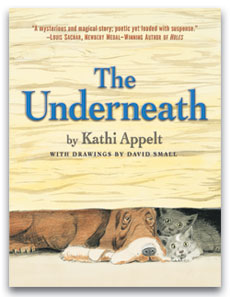Review
What the Woods Knew

In Kathi Appelt’s The Underneath, a gun-wielding ruffian named Gar Face lords over the wildlife of the East Texas Piney Woods with rage and rum-fueled violence. His grimy shack in a bone-strewn clearing is both hideout and hell. Even so, it’s paradise compared with his childhood home near the Houston Ship Channel. For readers who’ve driven through Baytown, the savvy of Gar Face’s change of scenery should be obvious. Location is everything.
In the case of The Underneath-a Newberry Honor Book and a finalist for the 2008 National Book Award for Young People’s Literature-location helps determine literary value. This elegant, sad-eyed novel for young adults is a prose poem to the woodlands of East Texas. Flush as it is with the landscapes surrounding Caddo Lake, elms, oaks and tupelos aren’t just scenery in Appelt’s Big Thicket; they’re the soul of the enchanted forest, the secret-keepers who know where all the bodies are buried.
One loblolly pine in particular knows enough to blow the lid off this Piney Woods Peyton Place. It knows that Gar Face craves to turn the Alligator King, a beast of the bayou, into pricey footwear. It knows that Puck and Sabine, two kittens who’ve lost their mother, yearn to make a home with Ranger, Gar Face’s bruised and bluesy hound. It knows that Grandmother Moccasin, a 1,000-year-old monster with an axe to grind, longs to bust loose of her underground cell to wreak havoc and revenge on the Thicket.

If this were “Falcon Crest,” Grandmother Moccasin would be Jane Wyman; if this were Kennebunkport, she’d be Babs Bush. In other words, she’s one pissed-off mama.
Each of these storylines is set spinning when a storm sweeps the forest, uprooting trees and flooding the creeks. Gar Face plots to turn Ranger and the kittens into gator bait. The Alligator King licks his chops. Grandmother Moccasin plans the destruction of joy and humanity. In a cleverly crafted finale, this evil triumvirate is pitted one against the other, and the trees conspire to help Ranger and the kittens escape to a happy ending.
It’s possible that this all sounds a bit Disney Adorable. (I happen to love Disney Adorable.) But the tone of The Underneath resists cuteness. This is The Fox & the Hound meets The Cherry Orchard; in more ways than one, Appelt has made her forest out of “pine.” From the start, the novel is motivated by a near-Chekhovian sense of sweet melancholy, a longing fueled by betrayal and loss. When its only little girl searches for her lost parents, Appelt writes: “The ground was too hard, the trees were too sparse. The sky was too big. ‘Where am I?’ she asked.”
It’s a resonant question given the novel’s concentration on place. Unlike Puck and Sabine-the two kittens who’re warned to stay hidden in “the underneath,” a (relatively) safe spot beneath Gar Face’s house-this child has wandered out of the forest’s refuge to grapple with cruel circumstance. It’s a path, in one form or another, that all The Underneath‘s characters must finally follow as each of their hiding places fails to protect them.
No matter what they’ve been running from-bruises, hunger or heartache-each is eventually forced to face facts and deal. Some find love and family, and some get eaten by an alligator. Either way, it’s better than Baytown.
Contributing writer and Texan in exile Robert Leleux, author of The Memoirs of a Beautiful Boy, lives in New York City.


